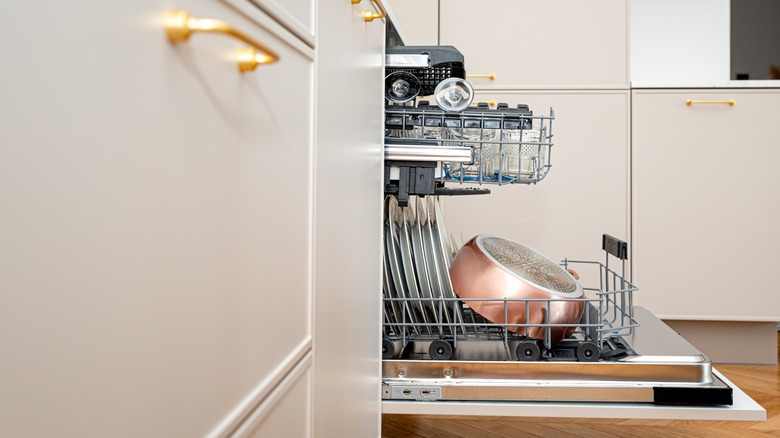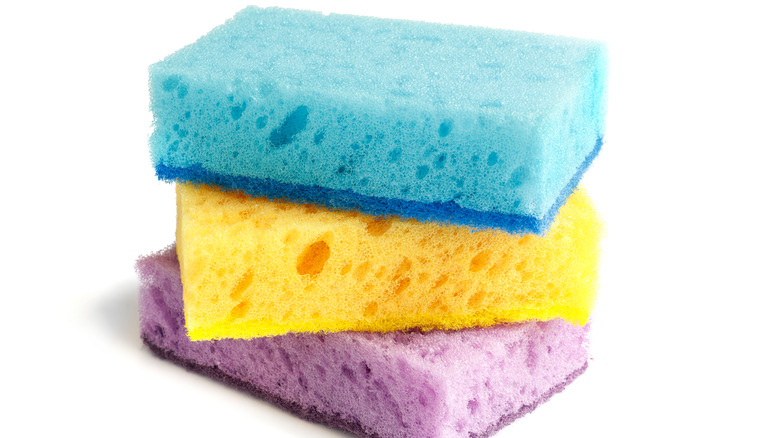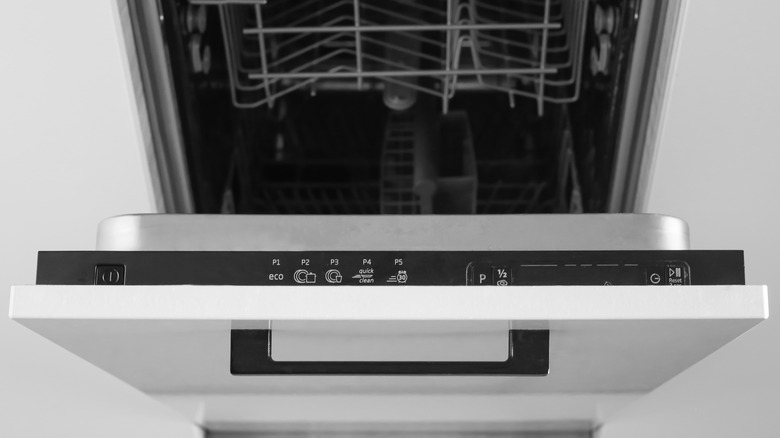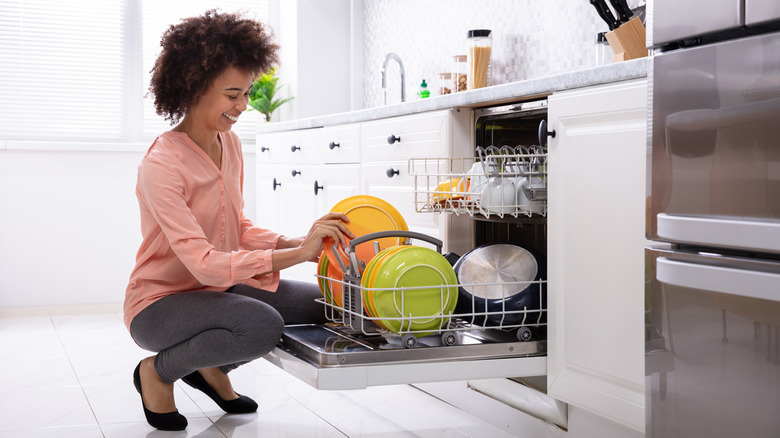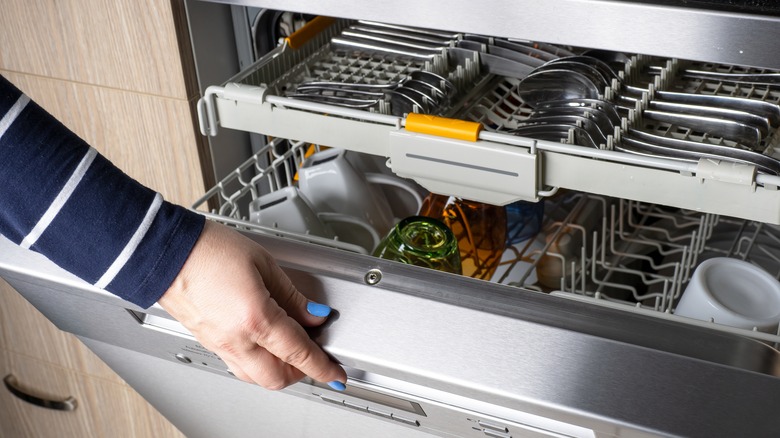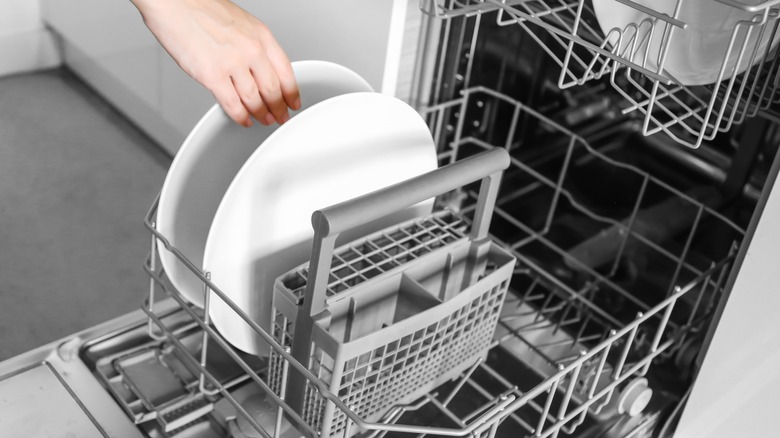8 Ways To Use Your Dishwasher Better
Dishwashers have evolved over the course of time since they became widely used in post-war domestic life. Make sure you're not still using yours like it's the 1950s. Here are some tips and ideas to stay up-to-date with the tasks this versatile appliance can tackle. Keeping your dishwasher clean is a must for keeping it in tip-top shape. It's also important to know what to leave out and how to load your dishwasher properly. Some of these tips will improve its performance, and others will simply make your life easier. And, isn't that what dishwashers are for?
To start using your dishwasher better, here's a quick anatomy lesson on your kitchen's hard-working appliance –- this will come in handy as we explore new and different ways to use it. A dishwasher is designed with one to three spray arms, located on the bottom and maybe on the top too. These spray your dishes with soapy water, rinse them, then dry them using heat coming from a heating element on the bottom. This process makes it an ideal appliance to clean a wide array of household items.
1. Think of your dishwasher as an all-around household cleaning machine
Use your dishwasher better by reframing how you think of it. If you're only loading it with dishes, you're seeing just some of its full potential. Your dishwasher can clean tons of household items such as makeup brushes, plastic hair brushes, nail clippers, razors, toothbrush holders, and soap dishes. It can give plastic kids' toys and fake plants and flowers a much-needed rinse-off. A quick cycle can easily get the grime off dog leashes and plastic pet toys, and degrease tools from the garage. Lots of items in your closet can also be run through the dishwasher including baseball hats, flip-flops, and rubber rain boots. Your kitchen likely has plenty of things that could use a good washing including sponges and silicone oven mitts. Even the removable shelves from your fridge, the plate from your microwave, and the knobs from your stove can go in the dishwasher.
Keep in mind that anything you're putting in your dishwasher will get wet, and anything placed on the bottom rack will be closer to the heating element (some plastics can melt). You can opt to run your dishwasher without soap or without heated drying if you're concerned about delicate possessions. If you have small or lightweight things that could fly around when hit by the water jets (Legos or pacifiers, for instance), place them in a mesh bag from your laundry room.
2. Know your chemical reactions
There are chemical reactions going on in your dishwasher, and knowing how they work can help you get more out of your machine. For one, modern detergent is made to interact with food particles. This is why experts now advise people to leave the food stuck on their plates when loading the dishwasher, as opposed to rinsing them off.
Another chemical reaction to be aware of is the effect of loading stainless steel and silver-plated flatware together. Silver ions reacting with detergent and humidity can leave pits and marks on your silver. Even when washing silver by itself, go for an acid-free and phosphate-free on your detergent and rinse aid, and go easy on the heat setting.
Want your dishes to be shiny and spotless? Some people swear by rinse aids, which work by altering the surface tension of water droplets in order to evaporate more quickly. Less water means fewer spots and etchings on glass. Even with a rinse aid, plastic takes longer to dry than glass because it is hydrophobic. Those looking for a more natural alternative to rinse aid might want to be aware of what vinegar can do. It can minimize hard water spots and help dry dishes better. Throw a splash in before starting up your machine, fill it into the rinse aid compartment, or place a bowl filled with vinegar in the top rack. Here's another option for spot-free shine — ball up some aluminum foil and secure it in your dishwasher's top rack. It will cause an oxidizing reaction, allowing your glasses and silverware to dry to a sparkling shine.
3. Use your levers
This is a favorite dishwasher hack because many people don't know about it. It's really simple and can change your dishwasher capabilities forever. Your dishwasher might be designed with levers to raise and lower the top rack by several inches. What this means is that you'll be able to raise it to re-arrange, move around, and fit large items like pots, trays, or those refrigerator shelves, on the bottom rack. Conversely, you'll also be able to lower the top rack so you can fit tall glasses, large mason jars, water bottles, and thermoses on top.
Dishwashers that have this feature allow owners to slide the top rack out all the way, then press down on hidden levers that either raise or lower the top rack. It's recommended to do this when the upper tray is empty to avoid damaging any dishes. This trick is yet another reminder that reading your appliances' manuals can allow you to use them to their fullest potential.
4. Is there a better way to unload the dishwasher? Yes
Sure, dishwashers make life easy when you're washing dishes, but they add a task to your to-do list every time it comes time to empty the dishwasher. Fortunately, you can put your dishwasher-emptying process on auto-pilot so you barely have to think about it. Don't forget to wash your hands before you begin, and have a dishtowel or two at the ready. Start by emptying the flatware section first, then the bottom rack, then the top rack. If you empty the top rack first, you might get drips falling on your dishes below — no thanks!
Clear a space on the countertop above the dishwasher. Spread a dishtowel out if you'd like. Stack all your dishes there in matching piles. Dry glassware and plastics if you need to with a dishtowel as you take them out. Divide flatware by the type on the dishtowel or between your fingers. Once everything is out, close the dishwasher door and move your dishes into their cabinets, drawers, and shelves. This method requires less back-and-forth around your kitchen, lets any drippy dishes dry, and uses minimal brain power. It's so easy you can teach kids to do it. Some people also like to clean their dishwasher filter, door, and seals every month or so, and check the bottom of their dishwasher for food remnants as they go. Doing so right after unloading the dishwasher is a perfect time!
5. Dry dishes faster by opening it sooner
Flash drying is a helpful trick to know about. Every dishwasher has a heating element in the bottom that turns on once the final rinse completes and the water has drained. This heating element heat-dries your dishes while the dishwasher is still closed. In most cases, your dishwasher's controls will show you when the rinse cycle has ended and the heating cycle is starting. Flash-drying is the act of opening the dishwasher door immediately after the final rinse cycle has ended and before the heat-dry begins. You may need to set a timer for yourself, but some dishwashers have settings to help you remember when to open it. Dishes will be hot and steamy, and the steam will evaporate quickly, leaving you with dried dishes in just a few minutes. The hotter the dishes, the quicker the drying. Your electricity bill will thank you, too.
Another method for getting dishes to dry faster includes using the towel trick. This hack is easy — at the end of your dishwasher's complete cycle, open the dishwasher, lay a terry cloth towel over the door so that half of the towel is on the inside, and close it back up. The towel will absorb most excess moisture in about five minutes.
6. A dishwasher can be used to rinse produce
Before using your dishwasher to clean food, make sure the unit and its filter are both nice and clean. Generally speaking, this method is better for heavier and thick-skinned produce such as apples, oranges, lemons, cucumbers, celery, and tomatoes. It is less optimal for smaller, delicate, and lightweight fruits like berries or leafy greens like romaine or bok choy.
Lay fruits and vegetables carefully on the top rack. Larger and heavier fruits and vegetables such as melons and pineapples can be put on the bottom rack. Settings should be turned to no heat and rinse only. Do not add soap or detergent to your dishwasher. You can add white vinegar instead for extra cleaning power if you'd like. This is all about giving your fresh groceries a nice, cold rinse with one easy push of a button. Bonus — depending on how much produce you have, this trick can help you save water.
7. Use your dishwasher as a plate warmer
Plate warmers aren't as common in home kitchens as they are in restaurants, but that shouldn't mean eating warm meals on cold plates has to be mandatory. Warm plates keep food in prime condition for eating longer and are especially beneficial for buffet-style meals. Make your home feel like a restaurant by warming up your plates before serving a homemade dinner. Half an hour to just minutes before plating your meal, simply load your clean dishes in a clean, empty dishwasher and turn the setting to heat-dry. There's no need to wash or rinse them. You can also warm up coffee mugs for comforting beverages on chilly mornings or dessert bowls for rich and melty brownies or pie.
Some dishwashers even have a plate warming setting. Plus, using a dishwasher to warm plates and bowls is quicker than running them under hot water. You won't have to dry them, and it's more foolproof than warming them in a hot oven since you won't risk them getting too hot.
8. Create an extra shelf, or remove one
Use your dishwasher better by learning how to remove your top rack. All dishwashers are different, but most will allow you to easily do so. This can be useful when you want to wash large items like cookie sheets in the bottom rack. Nearly all dishwasher top racks operate on a two-wheel track. With some, you can easily lift the rack out after you've pulled it out all the way. With others, you may need to remove the plastic end caps that lock the tracks into place.
Want to add a third upper rack for large utensils like tongs and spatulas? It's possible that you can utilize your dishwasher's space better by purchasing a simple dish rack and using it whenever you need a third rack. This works best with a flat-laying, durable, simple over-the-sink dish-drying rack. It can sit right on top of your glassware in your dishwasher and give you additional washing space.
